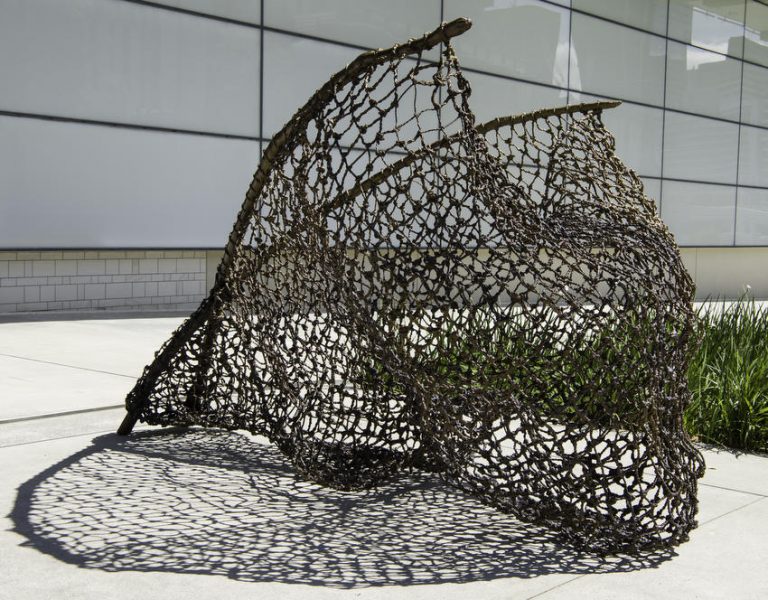We acknowledge the Traditional Owners of the land on which the Queensland Art Gallery | Gallery of Modern Art stands and recognise the creative contribution First Australians make to the art and culture of this country.

Judy Watson / Waanyi people / Australia b.1959 / tow row 2016 / Bronze / Commissioned 2016 to mark the tenth anniversary of the opening of the Gallery of Modern Art. This project has been realised with generous support from the Queensland Government, the Neilson Foundation and Cathryn Mittelheuser, AM, through the Queensland Art Gallery | Gallery of Modern Art Foundation / Collection: Queensland Art Gallery | Gallery of Modern Art / © Judy Watson
Judy Watsontow row 2016
On Display: GOMA
The Queensland Indigenous Artist Public Art Commission selected Judy Watson’s proposal for tow row 2016 to celebrate GOMA turning ten. The bronze sculpture is inspired by the traditional fishing nets woven by members of the Aboriginal communities of south-east Queensland.
Drawn from archival material in the Queensland Museum and State Library of Queensland, Judy Watson has put this humble, everyday object back into the landscape where it was once used, renewing an inherently local tradition and bringing it into contemporary memory.
The work evokes ideas of sustenance, family, culture and survival; its apparent fragility cloaks its hidden strength, a metaphor for the resilience of Aboriginal people who have held onto the land, culture and family through adversity and deprivation. It represents the enduring Aboriginal presence in this shared space.
Judy Watson was born in 1959 in Mundubbera, west of Maryborough, in south-east Queensland, and lives in Brisbane. The spirit and substance of her work can be found in the homeland of her grandmother and great-grandmother. A descendant of the Waanyi people of north-west Queensland, Watson completed a fine arts degree at the University of Tasmania in 1982.
While living in Sydney, Watson exhibited in the 1989 Artspace survey exhibition ‘A Koori Perspective’ and became associated with the Boomalli Aboriginal Artists Cooperative, which had been established to promote the work of urban Indigenous artists.
In 1995, she received the Moët & Chandon Australian Art Fellowship, and two years later was represented the country in the Australian Pavilion at the 47th Venice Biennale as part of ‘Fluent: Emily Kame Kngwarreye, Yvonne Koolmatrie, Judy Watson’. Watson’s work explores drawing, printmaking, painting and sculpture, all referencing an Indigenous connection to land and history.
Discussion Questions
1. How does Judy Watson’s sculpture show the strength of connection to an area that has undergone change?
2. Discuss the important role Indigenous Australians play in the narrative of place, community and culture within the Cultural Precinct.
Classroom Activities
1. In her sculpture, Watson used an everyday object that is meaningful to local Aboriginal communities. Draw an everyday object that is meaningful to you and connects you to a place. Discuss reasons for your choice.
2. Reflect on what you have learnt about the way the artist has used form, pattern and structure to communicate meaning. Now consider your school and what cultural values you would like to communicate about its history, community and environment. Design a model for a sculpture you would create to communicate these values and share this with your class.